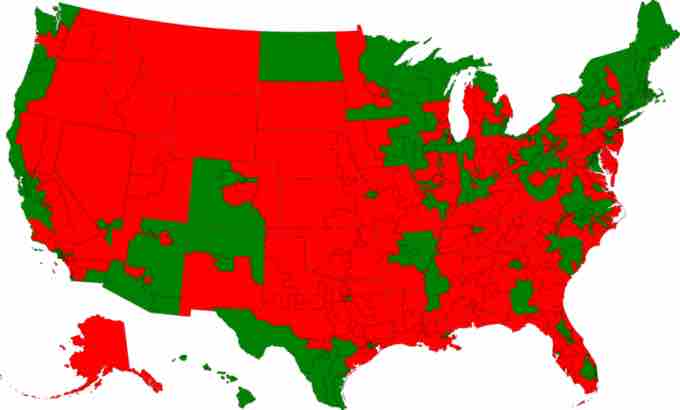Current issues in the U.S. health care system largely revolve around the significant policy changes imposed by the Affordable Care Act (ACA, or Obamacare), which attempts to provide health insurance coverage for all citizens. This legislation was designed to respond to many flaws in the current U.S. system of healthcare. It is also important to understand the criticisms of this change, as many voters in the U.S. disagree with proposed changes to the system.

U.S. House Votes for the Affordable Health Care Act
This map outlines the voting distribution in 2009 when the Affordable Health Care Act was brought to the floor.
U.S. Health Care Currently
The U.S., despite having some of the greatest technological advances and medical professionals, has consistently struggled to provide affordable, effective health care to everyone. The costs alone, on a per capita basis, underline the way in which the U.S. system has struggled to meet international standards in providing affordable care. illustrates the costs incurred by each individual in the system based on a country to country comparison. As it illustrates, consumers in the U.S. are faced with much higher (and growing) costs than international counterparts.

Health Costs Per Capita
This chart illustrates the costs incurred by each individual in the system based on a country to country comparison. As is demonstrated, consumers in the U.S. are faced with much higher costs (and consistently growing higher) than international counterparts.
Most Americans with private health insurance have it provided by their employers. There are also social welfare programs such as Medicaid and Medicare. The insurers negotiate rates with hospitals for different procedures. Patients then go into the hospital and get procedures recommended by doctors. The doctors are then paid by hospitals. This is a classic case of moral hazard: the two parties deciding for the transaction to occur- patients and doctors- are not the same two exchanging money.
Healthcare has a demand curve that fluctuates wildly based upon the extent of the issue - consumers who are facing serious health problems will likely demand healthcare at almost any price, allowing medical providers to take advantage of the inelastic demand. Further issues include the fact that doctors represent a third party (recommending drugs and procedures) and that insurance companies have the power to deny coverage to individuals who need it most.
The Affordable Health Care Act
In December of 2009, the Senate passing a bill called Patient Protection and Affordable Care Act. The Affordable Care Act is a complex piece of legislation, but a number of bullets from the bill are highly useful to understand:
- Pre-existing Conditions: Individuals with pre-existing conditions are much more likely to be expensive clients, and thus are not profitable to insure. This results in insurers refusing to insure these patients. The Affordable Care Act addresses this through legislation, saying providers cannot refuse coverage.
- Changing Insurance Rates: As a complement to the analysis above, insurance agencies also cannot alter rates based on pre-existing conditions or gender. This levels the playing field for the consumer, who historically had limited buyer power.
- Antitrust: Previously, insurance companies were immune to antitrust laws. This means they could generate monopolies geographically and exploit consumers. This immunity has been repealed.
- Standards: Obamacare also closes loopholes regarding to quality standards, ensuring that insurance providers do not reduce what is provided to clients in an effort to cut costs.
- Healthcare.gov: This is a way to enable consumers in finding health care insurers in a way that promotes capitalistic competition between providers. Previously, discussing pricing and plans with insurers was highly complex for many individuals (designed for businesses, not individual consumers).
- Medicaid and Medicare: Overall, medicare has been reduced while medicaid has been expanded. Medicare spending has been increasing dramatically. This has been cut by $400 billion, which is a source of discontent for many individuals. Medicaid has been expanded to 133% of the poverty level, covering more people.
Criticisms
The ACA will only work if both healthy and sick people alike buy insurance: if the healthy choose to pay the fine for not having insurance and only the sick buy insurance, then costs will increase. There is also a political critique of the ACA. Some feel that the government should not mandate that private citizens purchase insurance in the first place. They feel that the government is overstepping its bounds.
Many individuals also believe that this new legislation will increase costs for small businesses that are now required to buy insurance for their employees, and will motivate 'freeloaders', or individuals who take government handouts. Overall, while the goal is to enable more people to health care more affordably, many people believe this new approach will do not accomplish that.